Overview
- Brief Narrative
- Allied Military Authority currency, 5 francs, for use in France owned by and likely issued to Harold Burdette Conlan, a soldier in 701st D Company, US Army. This type of scrip was printed by the British and Americans for the June 1944 D-Day invasion and after. Military currency or occupation money was produced for use by military personnel in occupied territories. Conlan's unit was in Germany in early April 1945 and assisted in the liberation of Buchenwald concentration camp which was discovered by troops from the 6th Army on April 11, 1945. Starving prisoners had already seized control of the camp after the Germans began evacuations. Other US Army units soon arrived to help care for the over 20,000 ill and malnourished prisoners and restore order and sanitary conditions. The war ended with Germany's surrender on May 7, 1945.
- Date
-
issue:
1944
- Credit Line
- United States Holocaust Memorial Museum Collection, Gift of Ruth Conlan
- Markings
- face, four corners, blue ink : 5
face, top, purple ink : ĒMIS EN / FRANCE [Issued in / France]
face, center, black ink : 45969918
face, bottom, white on blue background : CINQ / 5 / FRANCS
face, top left, black ink : SERIE DE / 1944
face, bottom right, black ink : SERIE DE / 1944 - Contributor
-
Subject:
Harold B. Conlan
- Biography
-
Harold Burdette Conlan was born on April 25, 1905, to Howard and Lillian Lightcap Conlan in Salamanca, New York. He had a younger brother Robert. Harold grew up in Mansfield, Ohio. He was a truck driver. In early December 1941, the United States entered World War II (1939-1945.) Harold entered the Army on April 22, 1942. He was assigned to 701st Company D and deployed to Europe in 1944. In April 1945, his unit was in Germany. Harold and his unit assisted in the liberation of Buchenwald concentration camp near Weimar, which was discovered by the 6th Army on April 11.
The war ended on May 7, 1945, with Germany's surrender. Harold returned stateside and was released from the Army on September 21. He was married to Ruth Silcott (1914-2005). The couple had two daughters. Conlan brought home several items that he had found in the liberated Buchenwald concentration camp. When he told his family about that experience, he instructed them to care for and reverence the items and to never forget the tragic circumstance in which they were found. Harold, 73, passed away on January 4, 1978.
Physical Details
- Language
- French
- Classification
-
Exchange Media
- Category
-
Money
- Object Type
-
Occupation currency (lcsh)
- Physical Description
- Square 5 franc paper currency with a blue-green underprint with a dome flanked by torches with superimposed black wavy lines, and a decorative black border. The denomination 5 is in the 4 inner corners in dark blue ink. The serial number and French text are in the center. The denomination CINQ 5 FRANCS is in the bottom center. The reverse has a red and blue underprint with wavy, distorted lines and a geometric patterned blue border. In the center is a floating French flag with 3 vertical stripes: blue, white, red. Across the bottom of the flagpole is a decorative blue panel with scrollwork flourishes and the French national motto: Liberte Egalite Fraternite. The note is worn, slightly soiled, and has deep creases and folded corners.
- Dimensions
- overall: Height: 2.625 inches (6.668 cm) | Width: 3.000 inches (7.62 cm)
- Materials
- overall : paper, ink
Rights & Restrictions
- Conditions on Access
- No restrictions on access
- Conditions on Use
- No restrictions on use
Keywords & Subjects
Administrative Notes
- Legal Status
- Permanent Collection
- Provenance
- The scrip was donated to the United States Holocaust Memorial Museum in 1992 by Ruth Conlan, the wife of Harold Burdette Conlan.
- Funding Note
- The cataloging of this artifact has been supported by a grant from the Conference on Jewish Material Claims Against Germany.
- Record last modified:
- 2024-02-02 10:30:42
- This page:
- https://collections.ushmm.org/search/catalog/irn5803
Download & Licensing
In-Person Research
- By Appointment
- Request 21 Days in Advance of Visit
- Plan a Research Visit
- Request to See This Object
Contact Us
Also in Harold B. Conlan collection
The collection consists of a yarn doll, seven pieces of currency, a pennant, and a soap bar relating to the experiences of Harold B. Conlan, a soldier in the 701st Company D, US Army, which assisted in the liberation of Buchenwald concentration camp in Germany in April 1945.
Date: approximately 1945 April
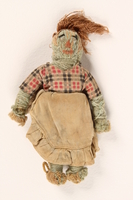
Yarn doll, bag, and scrap of money found in a liberated camp by US soldier
Object
Handmade yarn doll within a cloth pouch with a torn bit of currency found by Harold Burdette Conlan, a soldier in 701st D Company, US Army, under a makeshift bed in a dormitory at the liberated Buchenwald concentration camp in Germany. The camp was discovered by troops from the 6th Army on April 11, 1945. Starving prisoners had already seized control of the camp after the Germans began evacuations. Other US Army units soon arrived to help care for the over 20,000 ill and malnourished prisoners and restore order and sanitary conditions. The war ended with Germany's surrender on May 7, 1945. Conlan instructed his family to reverence the items he had found and to never forget the tragic circumstance in which they were found.
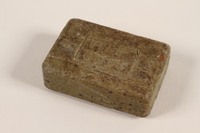
Soap found in a liberated concentration camp by a US soldier
Object
Bar of soap mass produced in wartime Germany found by Harold Burdette Conlan, a soldier in 701st D Company, US Army, at the liberated Buchenwald concentration camp in Germany. The camp was discovered by troops from the 6th Army on April 11, 1945. Starving prisoners had already seized control of the camp after the Germans begun evacuations. Other US Army units soon arrived to help care for the over 20,000 ill and malnourished prisoners and restore order and sanitary conditions. The war ended with Germany's surrender on May 7, 1945. Conlan instructed his family to reverence the items he had found and to never forget the tragic circumstance in which they were found.

Red pennant with swastika found at a liberated concentration camp by a US soldier
Object
Small Nazi pennant with a swastika on a white circle found by Harold Burdette Conlan, a soldier in 701st D Company, US Army, at the liberated Buchenwald concentration camp in Germany. The camp was discovered by troops from the 6th Army on April 11, 1945. Starving prisoners had already seized control of the camp after the Germans begun evacuations. Other US Army units soon arrived to help care for the over 20,000 ill and malnourished prisoners and restore order and sanitary conditions. The war ended with Germany's surrender on May 7, 1945. Conlan instructed his family to reverence the items he had found and to never forget the tragic circumstance in which they were found.
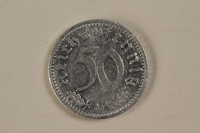
Nazi Germany, 50 reichspfennig coin found by an American soldier/liberator
Object
German 50 pfennig coin found by Harold Burdette Conlan, a soldier in 701st D Company, US Army, at the liberated Buchenwald concentration camp in Germany. The camp was discovered by troops from the 6th Army on April 11, 1945. Starving prisoners had already seized control of the camp after the Germans begun evacuations. Other US Army units soon arrived to help care for the over 20,000 ill and malnourished prisoners and restore order and sanitary conditions. The war ended with Germany's surrender on May 7, 1945. Conlan instructed his family to reverence the items he had found and to never forget the tragic circumstance in which they were found.
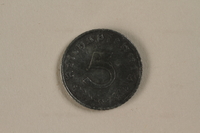
Nazi Germany, 5 reichspfennig coin found in a liberated camp by an American soldier
Object
German 5 pfennig coin found by Harold Burdette Conlan, a soldier in 701st D Company, US Army, at the liberated Buchenwald concentration camp in Germany. The camp was discovered by troops from the 6th Army on April 11, 1945. Starving prisoners had already seized control of the camp after the Germans begun evacuations. Other US Army units soon arrived to help care for the over 20,000 ill and malnourished prisoners and restore order and sanitary conditions. The war ended with Germany's surrender on May 7, 1945. Conlan instructed his family to reverence the items he had found and to never forget the tragic circumstance in which they were found.
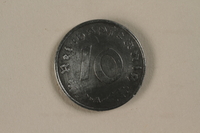
Nazi Germany, 10 reichspfennig coin found in a liberated camp by an American soldier
Object
German 10 pfennig coin found by Harold Burdette Conlan, a soldier in 701st D Company, US Army, at the liberated Buchenwald concentration camp in Germany. The camp was discovered by troops from the 6th Army on April 11, 1945. Starving prisoners had already seized control of the camp after the Germans begun evacuations. Other US Army units soon arrived to help care for the over 20,000 ill and malnourished prisoners and restore order and sanitary conditions. The war ended with Germany's surrender on May 7, 1945. Conlan instructed his family to reverence the items he had found and to never forget the tragic circumstance in which they were found.

Nazi Germany, 10 reichspfennig coin found in a liberated camp by an American soldier
Object
German 10 pfennig coin found by Harold Burdette Conlan, a soldier in 701st D Company, US Army, at the liberated Buchenwald concentration camp in Germany. The camp was discovered by troops from the 6th Army on April 11, 1945. Starving prisoners had already seized control of the camp after the Germans begun evacuations. Other US Army units soon arrived to help care for the over 20,000 ill and malnourished prisoners and restore order and sanitary conditions. The war ended with Germany's surrender on May 7, 1945. Conlan instructed his family to reverence the items he had found and to never forget the tragic circumstance in which they were found.
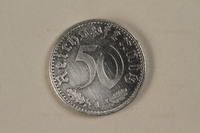
Nazi Germany, 50 reichspfennig coin found in a liberated camp by an American soldier
Object
German 50 pfennig coin found by Harold Burdette Conlan, a soldier in 701st D Company, US Army, at the liberated Buchenwald concentration camp in Germany. The camp was discovered by troops from the 6th Army on April 11, 1945. Starving prisoners had already seized control of the camp after the Germans begun evacuations. Other US Army units soon arrived to help care for the over 20,000 ill and malnourished prisoners and restore order and sanitary conditions. The war ended with Germany's surrender on May 7, 1945. Conlan instructed his family to reverence the items he had found and to never forget the tragic circumstance in which they were found.
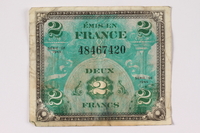
Allied Military Authority currency, 2 francs, for use in France, owned by a US soldier
Object
Allied Military Authority currency, 2 francs, for use in France owned by and likely issued to Harold Burdette Conlan, a soldier in 701st D Company, US Army. This type of scrip was printed by the British and Americans for the June 1944 D-Day invasion and after. Military currency or occupation money was produced for use by military personnel in occupied territories. Conlan's unit was in Germany in early April 1945 and assisted in the liberation of Buchenwald concentration camp which was discovered by troops from the 6th Army on April 11, 1945. Starving prisoners had already seized control of the camp after the Germans began evacuations. Other US Army units soon arrived to help care for the over 20,000 ill and malnourished prisoners and restore order and sanitary conditions. The war ended with Germany's surrender on May 7, 1945.



